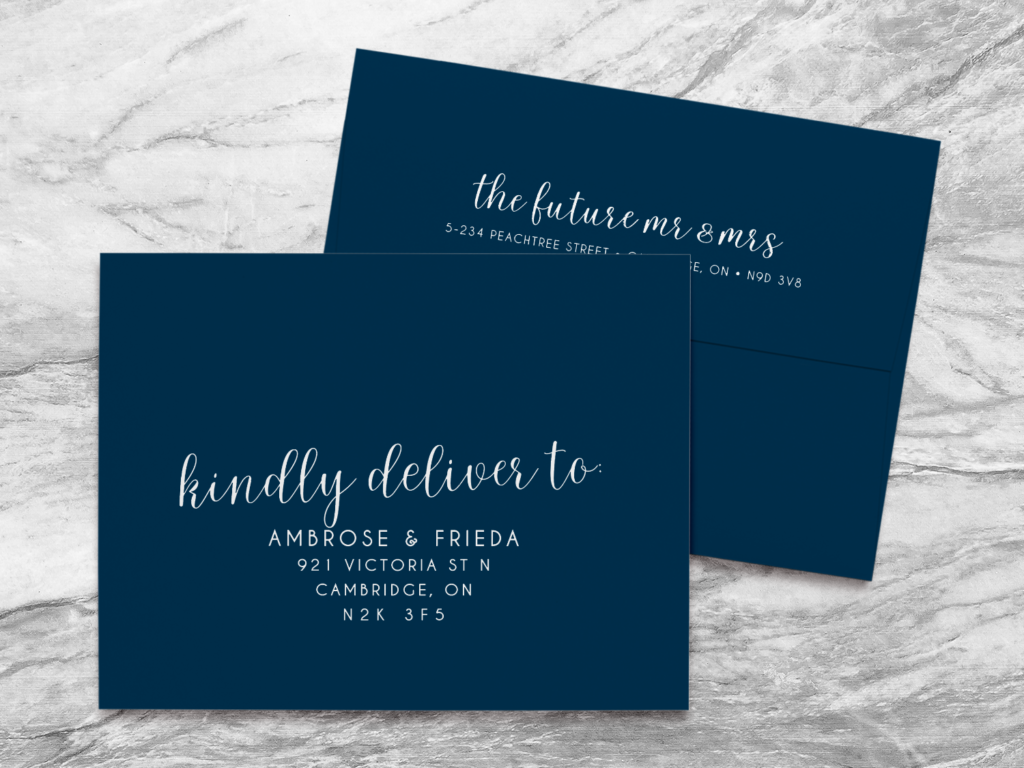
When it comes to addressing your wedding invitations, sometimes the rules can be a bit tricky. I know envelope addressing may not be the most exciting part of your wedding planning, but getting it right will really mean a lot to your guests — especially if you’re planning a traditional wedding. If you’ve decided you want to go that route and follow those etiquette rules, I’ve got you covered. In this guide, I’ll go through some general rules for how to address your wedding invitations as well as how to handle titles and mailing address rules.
But before I get into the tips, there’s one thing I want to address: double envelopes. So, if you are having a super traditional wedding, you might choose to use double envelopes. But for most couples, you do not need a second envelope. It’s an antiquated piece that has its roots in an old-timey and failing postal system that often ruined outer envelopes. That’s just my opinion on that. 😉
So with that out of the way, let’s talk general addressing rules.
Invitation Addressing General Rules
To make it as simple as possible, I’ve put together a few general rules to follow with your wedding guest addresses. Here are the basics:
- Spell out first and last names
- Spell out “and”
- A couple’s child who is over 18 should receive their own invitation
- No need to include children’s last names if they’re under 18
- Include married couples on the same line if they have the same last name
- People with different last names on different lines
- List same-gender couples in alphabetical order
- If a couple does not live together, send their invite to the one who is your closest friend
Handling Wedding Guest Titles
One of the trickiest parts of guest addressing is how to treat official titles. Generally, it’s a sign of respect to get these right, so make your best effort to find out from your guests what their titles are if you’re not entirely sure.
- Most men: Mr.
- Single women: Miss or Ms.
- Married women: Mrs.
- Divorced women using their married name: Mrs.
- Divorced women using their maiden name: Miss or Ms.
- Judges: The Honorable
- Clergy: The Reverend
- Medical doctor: Doctor
- Ph.D.: Dr.
- Military officer: Use their title
As I mentioned, using proper titles for your guests is a sign of respect, especially if the rest of your invitation and wedding are particularly formal or traditional. If you’re not going for a traditional wedding, you can get away with eliminating titles altogether if you wish.
How to Address Your Wedding Invitations
The next thing to handle is the actual mailing address part. Generally, you’ll want to be sure to follow postal service formatting to avoid problems with delivery. Each national postal service (like the USPS, CanadaPost or Royal Mail) have their own rules about formatting. If you’re not used to writing out addresses, check with local postal service for their general rules.
That said, there are some etiquette rules involved as well. Here are the basics:
- Use numerals for house numbers & postal/zip codes
- Write out “Street” “Boulevard” etc.
- Write out state and province names in full
To help you out, here are a couple of examples of full addresses:
- Example US address:
MR. JOHN AND MRS. DEANNE SMITH
921 VICTORIA STREET NORTH
CHICAGO, ILLINOIS
60604
- Example Canadian address:
DOCTOR AND MRS. JOHN SMITH
JORDAN, JENNY AND MICHAEL
921 VICTORIA STREET NORTH
CAMBRIDGE, ONTARIO
N2K 3F5
Formatting Your Return Address
Your return address is the final touch on your invitation envelopes. This is one area where you can get a bit more creative since most returned mail will have to be handled in person at some point anyway. So, consider how you want to design your return address. Here are a few guidelines:
- Place the address in upper left corner of front or on back flap
- Use the return name and address of the person or people handling RSVPs
- Follow the same address rules as above
One note about your return address if you choose to place it on the back flap of your envelope. Because most mail is run through automatic processing machines, avoid formatting any addresses on the flap in the multi-line format so as not to confuse the machines and end up getting your invitations mailed back to you by mistake! Instead, format the address portion of the return address in a single line.
Whew! After all that, you should be more than prepared to address your wedding invitations and get this detail out of the way. If you found this article helpful, I’d love if you would share it with a friend or pin it to Pinterest! Now all you have to do is decide between hand-lettering, printing or labelling your addresses! And if you still haven’t gotten around to your invitation wording, grab my wedding invitation wording guide as part of my free wedding planning resource library.

